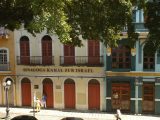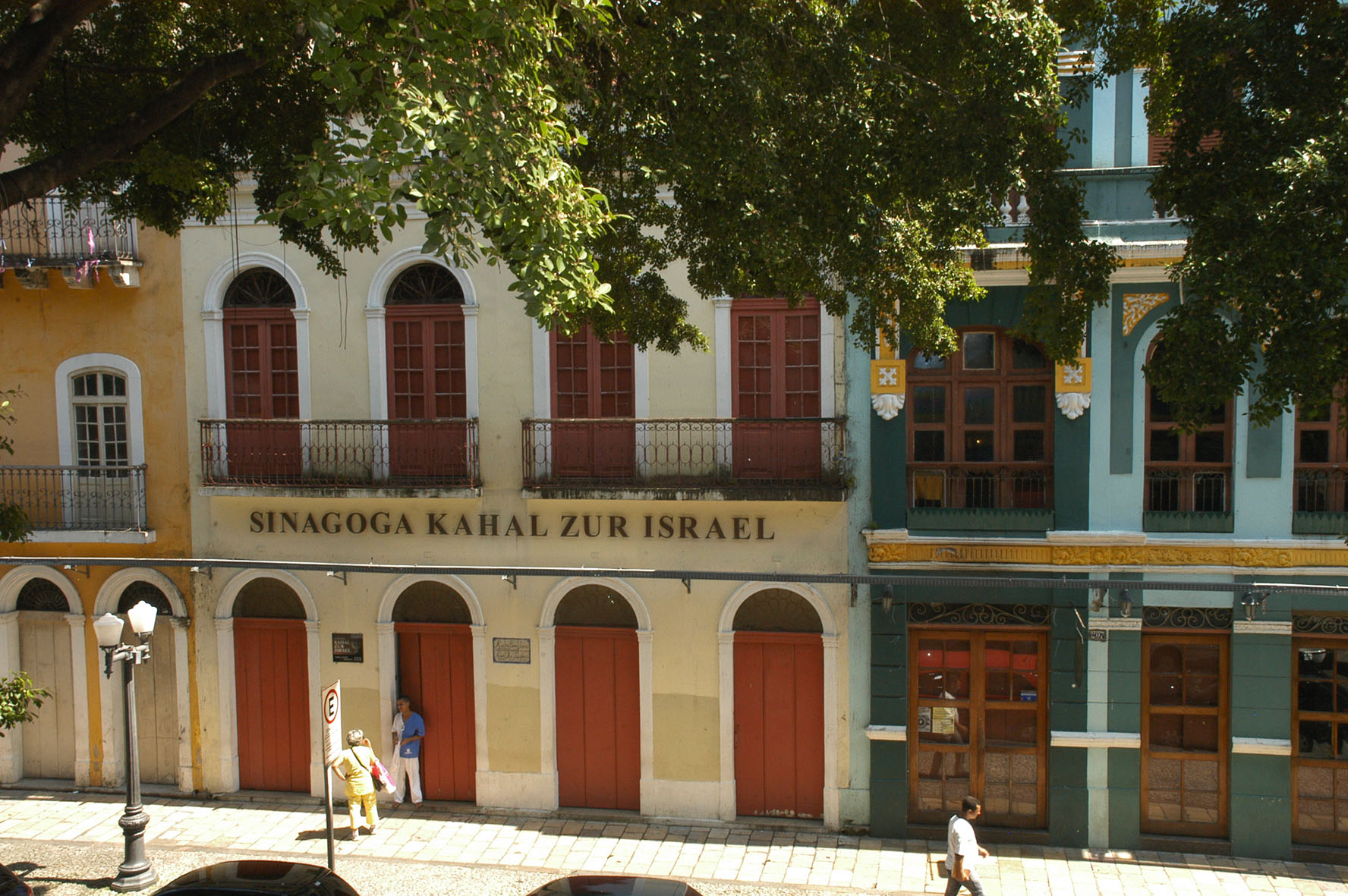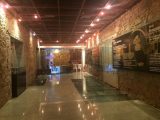Este post também está disponível em:
Português
English

The Kahal Zur Israel Synagogue was founded in the first half of the 17th century, the Israeli congregation of Rua do Bom Jesus is recognised as the oldest synagogue in the Americas.
The remains that prove the existence of the place of worship were found in archaeological excavations between the years 1999 and 2000 and today are exposed in the space that functions as a museum and Jewish cultural centre.
The Kahal Zur Israel Synagogue (Congregation Rock of Israel) was the first synagogue in the Americas and operated in Pernambuco during the period of Dutch domination (1630-1657).
The Israeli community has participated in Pernambuco life since the colonial era, with a preserved cultural and religious tradition.
More than a religion, Judaism is linked to the history of a people that became a nation three thousand years ago.
Currently, the Israeli Federation of Pernambuco (FIPE) estimates that there are about 1.5 thousand Jews living in the state – the vast majority of them live in the capital, having a small impact on the daily life of the city.
Video “Kahal Zur Israel Synagogue”

Sinagoga Kahal Zur Israel em Recife
History of the Kahal Zur Israel Synagogue
A very different scenario from that found in the 17th century, when the Jewish population in Recife was similar to that of today, but in a province with just over 10,000 inhabitants.
There are currently about 1500 Jews in Pernambuco. To be Jewish, one must be the son of a Jewish mother or have converted to Judaism.
The first migratory flow of Jews to Recife occurred in the 17th century and brought people from the Iberian Peninsula. “They were fleeing the religious inquisition.
In Portugal, there was a mass conversion of Jews to Christianity for this reason. They were called new Christians,” he explains.
Christian converts and those fleeing conversion arrived in Recife and practised Jewish rites and customs at home to avoid the accusation of heresy.
Conversion and hidden practices were not a choice, the crypto-Jews – as those who practised their beliefs in a veiled way became recognised – had death at the stake in the public square as a certain fate if they met the inquisition.
Conversion: The conversion process can take up to two years of study of Jewish history and culture and some Hebrew language. At the end of this period, the person participates in a Beit Din (a kind of rabbinical court), composed of three members who will assess whether the individual is fit to join Judaism.

Jewish history researcher Odmar Braga points out that even before the first great migration, which took place in the 17th century, “new Hispano-Portuguese Christians” were already arriving on Pernambuco soil.
“Two synagogues existed between 1580 and 1595. One in Alto da Ribeira and the other in the Camaragibe mill, owned by the same family,” he explains.
In the 17th century, however, the Dutch invasions changed this scenario, albeit momentarily. “The Netherlands was a Calvinist country, defending different religious shades. This allowed Judaism to be practised freely in Recife between 1630 and 1654. The inquisitor Portuguese left the scene and the tolerant Dutch entered,” Tachlitsky says.
Traditions: at 8 days old, Jewish boys undergo circumcision, which consists of removing the foreskin from the penis. At 13, these boys participate in the Bar Mitzvah, which marks the “religious majority”. The girls’ comes at the age of 12, at the Bat Mitzvah.
After the arrival of the Dutch, and the consequent religious freedom, Braga reports that the remnants of the Alto da Ribeira and Camaragibe synagogues, together with their children, circumcised themselves and founded the Manguén Abraham Synagogue.”Later, they were also responsible for founding the Kahal Zur Israel Synagogue,” he says.

Researcher and founder of the Jewish Historical Archive of Pernambuco, Tânia Kaufman, says that with the domination of the Netherlands, this Jewish contingent of Iberian origin, called Sepharadites, unlike the new Christians who arrived in the city at the beginning of colonisation, did not need to hide their beliefs.
They already found a Jewish atmosphere in Recife. “They began to enjoy the protection of the government of João Maurício de Nassau and the privileges of the social and economic elite at the time,” he says.
Given the favourable scenario, Jewish immigration reached its peak. Odmar Braga reports as the peak the arrival of Rabbi Isaac Aboab da Fonseca, who had the Catholic name of Simão da Fonseca and studied to become a rabbi after his family fled to Amsterdam.
Tânia Kaufman points to this event as a sign that Jews began to put down roots in the city, to the point of enabling the first rabbi in the Americas
“It was also at this time that the first synagogue in the Americas (Kahal Zur Israel Synagogue) was built, occupying one of the mansions on Rua do Bom Jesus, then called Rua dos Judeus”, Kaufman points out. Construction of the synagogue began in 1638 and was completed in 1641.”

The Dutch period, although productive for the Jews, was short-lived. Just over 20 years later, the Portuguese regained control of the colony, generating a mass migration to the interior of the state – especially the Sertão, where it was easier to maintain Jewish customs.
There, they would be out of reach of the Portuguese Inquisition, which occasionally made incursions to pursue heretics and then take them to Portugal to be judged by the Holy Inquisition.
“Given the large number of Jews living in Pernambuco and the small physical space of the ships of that time, many were unable to leave the country and decided to remain in the Sertão and other locations beyond the border of Pernambuco.”
Read – The Jews who built Brazil – Unpublished sources for a new view of history.
The second Jewish migration and the Boa Vista neighbourhood
Pernambuco once again entered the Jewish route at the end of the 19th century and in the first decades of the 20th century.
This time, as a destination for those fleeing persecution in Europe, especially in the east of the continent.
Jáder Tachlitsky himself has stories of this migration in his family.
His grandparents came from Ukraine fleeing the persecution promoted by the Russian tsars in the region. “Hitler did not create the persecution of Jews, but he took it to a more extreme level, killing millions of people. Before that, Jews were already persecuted across Europe,” Tachlitsky points out.
These Jews, who were called Ashkenazis, arrived in the city with a different status from those who came during the first migration, who consolidated themselves as the elite of Recife. Both the economist’s great-grandfather and grandparents worked in informal commerce in the Pernambuco capital.
“They arrived in a difficult situation. They travelled through more isolated neighbourhoods at the time, such as Beberibe and Casa Amarela, and sold goods on credit, in 10 to 15 instalments. So they prospered,” he says.
He says that, because of the history of persecution, Jews maintained the habit of living close to each other, something that remained in the Boa Vista neighbourhood until the 1970s. “The neighbourhood was home to the synagogue, the Israeli Club and the Israeli College. There was this custom of always having everything close by. The Maciel Pinheiro Square, for example, was a meeting point for the Jewish community,” he emphasises.
Sacred Recife Route
In the Sacred Recife itinerary, the 1st Synagogue located on Rua Martins Júnior, in the Boa Vista neighbourhood, the Shil Sholem Ocnitzer or Israeli Synagogue of Recife was inaugurated on 20 July 1926. Currently, the site no longer hosts religious gatherings.
Boa Vista: the neighbourhood in the Centre of Recife concentrated Jewish housing in Recife until the 70s. According to Tachlitsky, Praça Maciel Pinheiro was a kind of meeting point. The house of writer Clarice Lispector, who was Jewish, is located in the vicinity of the square.
The result is that the second community entered Brazil through the less privileged layers of society, as Tânia Kaufman explains.
“The first contacts were with people with lower purchasing power through commercial relations. The Jews quickly succeeded and became traders in fixed points in the Boa Vista neighbourhood,” she says.
They then established themselves in commercial houses concentrated on Rua da Imperatriz Tereza Cristina and its surroundings. Space that was occupied for both commerce and residential use.
Tourism and Travel Guide to Recife, Pernambuco and the Northeast of Brazil
Religious Tourism and Sacred Recife
Tourism and Travel Guide of the Northeast



















